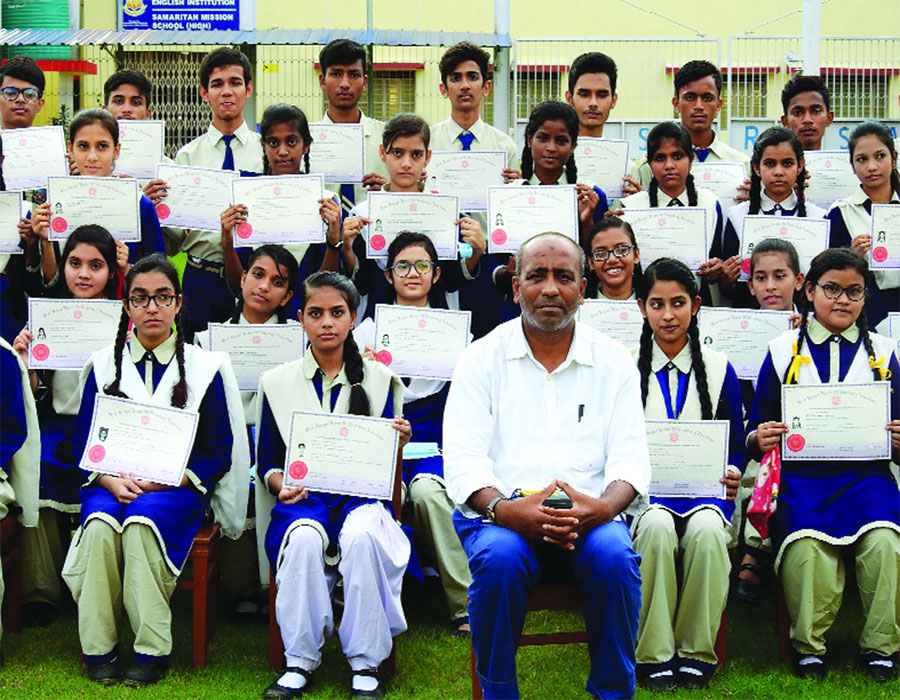The poor have found innovative ways of helping themselves and visionary leaders from among these communities are nurturing a growing industry of good quality private schools
The state of India’s school education continues to be abysmal despite so many high-sounding policy prescriptions being tossed around. There are, however, islands of excellence and even in this bleak landscape there are shoots of green. While Government schools are the mainstay of school education for the poor, some exceptional private schools are affordable even to the extremely marginalised. The accepted wisdom is that private schools serve the privileged; everyone else, especially the underprivileged, requires public schools. This logic is grounded on the assumption that the poor need Government assistance if they are to get a good education. Which helps explain why many school choice enthusiasts believe that the only way the poor can get the education they deserve is through Government schools.
But if we reflect on some of the underprivileged communities, we find these assumptions lacking. The poor have found remarkably innovative ways of helping themselves educationally and visionary leaders from among these communities are nurturing a large and growing industry of good quality private schools. Tikiapara, a sprawling slum in Howrah, is a witness and a willing participant in a quiet revolution led by Mamoon Akhtar that has the potential to turn around the lives of its residents, especially of its children. Mamoon was forced to drop out of middle school because his parents couldn’t afford to educate him further. Three decades later, he is the driving force two schools in Tikiapara with 3,000 students, most of them children of unlettered parents. Mamoon’s extraordinary journey from a victim to champion of the underprivileged started the day he decided that just because his family couldn’t pay for his schooling, he wouldn’t forego education. Mamoon’s passion helped him overcome his deprivation.
His father was keen that his son get a good education. So he put him in one of the area’s leading schools, St Thomas. After his father died, the teenager had to give up his studies and took up a librarian’s job at a private school in Tikiapara, supplementing his income by giving private tuitions. Life would have gone on as usual but Mamoon couldn’t get over the tragedy he suffered on being forced to lose out on education. The young idealist believed in giving direction to the fire within, not in extinguishing it.
In 1991, he started an informal “school”, teaching five to six children in his own house in the Tikiapara slum. Thus began his lifetime romance with education. As the residents of the area became aware of this “school”, more and more children started coming and soon there was no place to seat them. The enterprising Mamoon constructed a room on his own 600 square foot plot of land. In that one room, the Samaritan Help Mission School was born with 25 young and eager children flocking to it daily. The good Samaritan stretched his every rupee and canvassed from door to door to raise Rs 28,000 per annum (in addition to his own contribution of Rs 10,000). The organisation has continued to steadily grow through the years. The catchment area of the school can break the determination of even the greatest optimist but Mamoon is alive and equal to the challenge. The parents come from very poor backgrounds, some are rickshaw-pullers, drug peddlers and daily labourers. But with Mamoon’s effort, their dreams of educating their children in an English-medium school has become a reality.
Social responsibility: As an educationist, Mamoon is also sharply aware of his role of a social reformer. Most children come from families afflicted with social maladies, with a large number of them being children of drug peddlers. Mamoon believes that schools should have the right to exclude pupils only as a last resort and that too, to protect the other children in the class as well as teachers. The excluded children, he avers, can be affected by anxiety, depression and loss of self-worth. There is a decline in their mental health and children become very reclusive. The stress of the exclusion takes its toll on parents, too.
Mamoon knows the pain of deprivation only too well. At a time when there is a widespread practice of pupils being shunted off a school’s rolls in order to manipulate its exam results or rankings in league tables — he is doing his every bit to ensure that children remain at school during the day. There are hundreds of pupils who joined his school after being booted out of another one. Taking in as many vulnerable pupils as possible is the core of this teacher’s mission. His school is single-handedly ensuring pupils remain on the rolls. There are a number of youngsters who wouldn’t be getting an education were it not for the Samaritan Help Mission School. In a world where schools are clearly pushing vulnerable pupils out through the back door with little thought to their next steps and best interests, he is embracing them with a cheerful heart.
With a little help from friends: When he canvassed for help from the community around him, Mamoon reaped a bonus — a strong connect with the community. In 2007, the Samaritan Help Mission School became accredited and recognised by the West Bengal Government. Today, it is a co-educational English-medium school, affiliated to the State Board of Secondary Education, with an enrolment of 1,300. The big thing is that with the school being an English medium one, it makes a major difference to the future prospects of the kids once they go out into the world. However, the odds are stacked against the children of this locality given the inter-generational nature of poverty and the poor developmental outcomes that families face. This impacts the children in many ways. They battle poor academic achievement, inferiority complex, maladjustment, lack of initiative and an underdeveloped personality. Disheartened and discouraged by financial stress and their own inadequacy, parents are ill-equipped to adequately support their children. Sadly, parents in Tikiapara have little motivation to invest in their children’s education. Fortunately, Mamoon’s conviction and commitment are unflagging and his enthusiasm is contagious, sending hope in the community.
Some of the students are orphans; some have run away from home; all are underprivileged. The Samaritan Help Mission School charges them a measly Rs 5 a year, and that too because the teacher believes that people will not value anything that is free. Funds to run the school come from Mamoon’s savings and private donors whose motivation is inspired by the good Samaritan’s devotion. This led to an addition to the original school on Mamoon’s plot, the IR Belilious Institution on Belilious Road, covering two acres of land bequeathed by a Jewish couple, Rebecca and Isaac Raphael Belilious. The school today has a football field, basketball court, a water body, a two-storeyed school building and a bigger one coming up close by. As a child Mamoon swam there, to later see the water body turn into a municipal garbage dump and the Government school that used to run there become virtually defunct, the whole space go derelict and transform into a den of drug pushers. The land on which the second Samaritan Help Mission School stands had thus been a garbage dump for years until Howrah City Police and the Howrah Municipal Corporation got together to create a conducive atmosphere for Mamoon to expand his initiative. The police helped them (Mamoon and his staff) build a wall, remove encroachments and start a school there.
Creating safe spaces for children at risk: Many children studying in the two schools attest to the fact that they have a fun-filled, interactive and encouraging atmosphere and that the teachers are extremely supportive. Children are engaged in creative activities like sports, quiz competitions, picnics and recreational programmes in the local parks. Regular cleaning campaigns in Tikiapara are organised in which students, teachers and other volunteers take an active part. Mamoon has also introduced a paramedic course for senior students. His policy of inclusive education has ensured that the constitutional right to primary education is a reality in this slum. There are schools which identify parents who are not well-educated and living in the slum. They are approached informally and told that it “will be difficult for your child to stay” in the hope that the parents agree to move out or home-school their child. But Mamoon’s schools are a safe learning haven where no one is shunned — either because of creed, low academic scores or poverty.
Innovative approaches: Mamoon says that the process of teaching and learning is an intimate act that neither computers nor markets can hope to replicate. It is a small wonder then that the technology-centric corporate business model has not worked in reforming the school system as there is simply no substitute for the personal element. There is no substitute for a good teacher and nothing more valuable than quality classroom instruction. But we also need more involved parents to make leaning more effective.
The core objective of a school is to provide high-quality instruction: Fostering both excellent teaching and a learning environment in which students can thrive. These schools don’t develop randomly on their own; an essential ingredient behind each of these success stories is transformational leadership.
A lot of good programmes got their start when one individual looked at a familiar landscape in a fresh way. What they did was to simply change the fundamental approach to solving problems, and the outcomes have been truly revolutionary. Thus, people only need to summon their will power the way game-changers like Mamoon are doing to bring about change.
(The writer is a well known development professional)








 OpinionExpress.In
OpinionExpress.In















Comments (0)